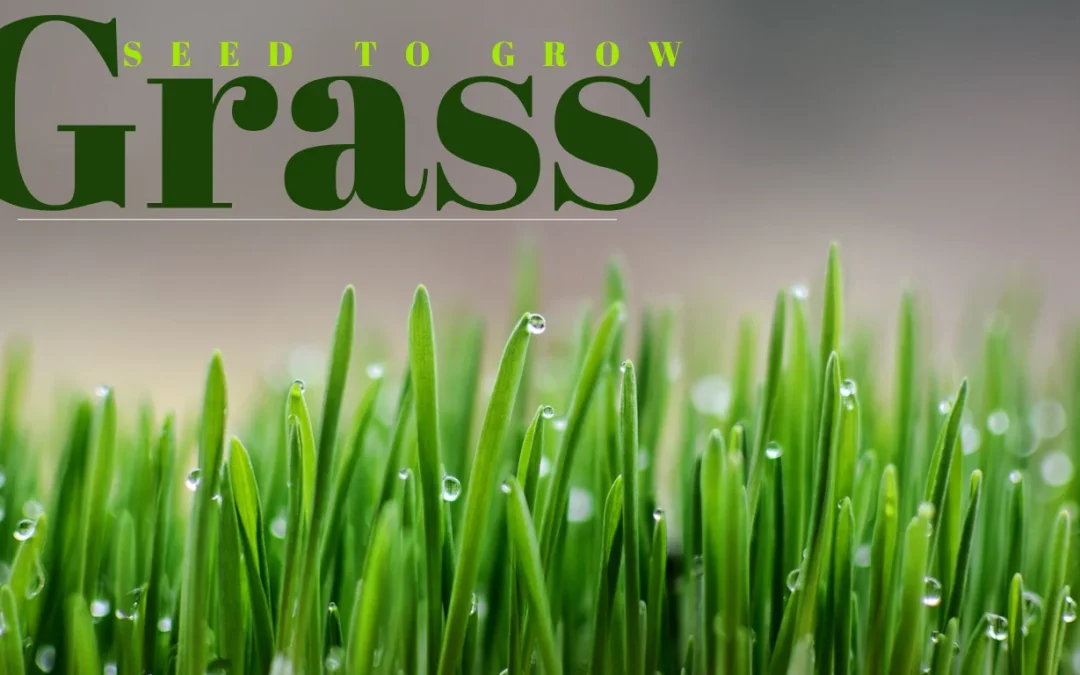Did you know a well-maintained lawn can boost a property’s value by up to 15%? The first step to a lush lawn is planting grass seed. But, many wonder about the grass seed growth timeline. Homeowners eagerly wait for their yards to turn green and wants to know how long does it take for grass seed to grow ?
Understanding the seed germination process is crucial. It can make or break your lawn. Many new lawn owners want quick results. But, successful lawn establishment requires patience and careful planning.
Many factors affect how fast grass seed grows. The type of grass, planting conditions, and care all matter. Knowing this helps set realistic expectations for your lawn’s growth.
Table of Contents
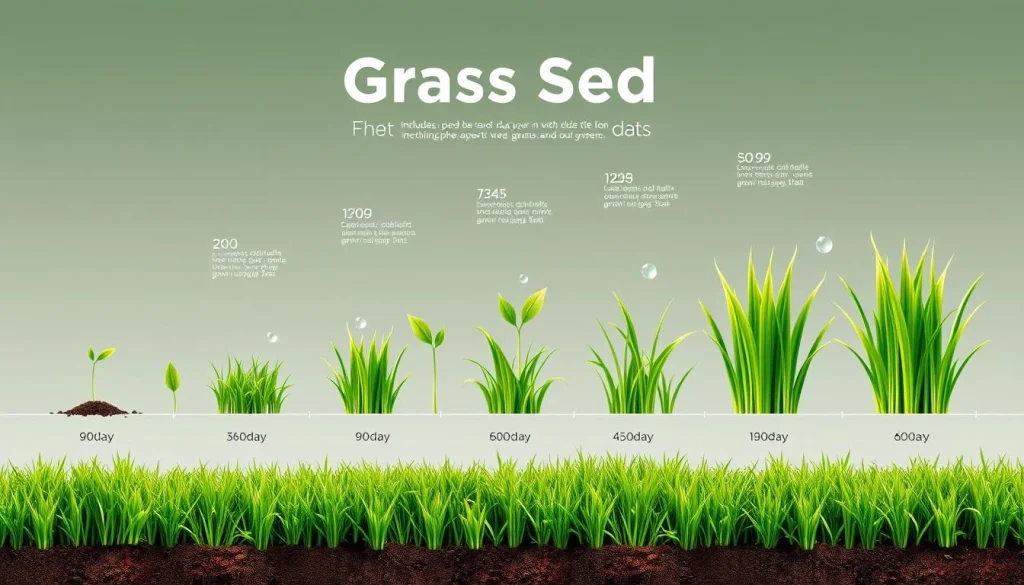
- The impact of a beautiful lawn on property value can be significant.
- Achieving a full, lush lawn begins with proper knowledge of the grass seed growth timeline.
- The anticipation for lawn establishment requires patience and an understanding of seed germination.
- Factors like grass variety, planting conditions, and lawn care impact growth rates.
- Setting realistic expectations is key for homeowners ready to invest in their lawns.
Understanding the Germination Process of Grass Seed
Grass seed germination is key to growing a healthy lawn. It’s influenced by many factors. Knowing what seeds need can help grow a lush lawn.
The Role of Temperature and Moisture in Germination
Temperature and moisture are crucial for seed germination. Seeds need a certain temperature range to grow. Most grasses germinate best between 50°F and 65°F (10°C and 18°C).
Moisture is also essential. Seeds need enough water to swell and break through their casing. Without the right conditions, seeds may not sprout well.
Grass Seed Germination Stages
Grass seed development has several stages:
- Imbibition: Water absorption causes the seed to swell, breaking the seed coat.
- Activation: Water activates growth enzymes and the seed’s metabolism kick-starts.
- Emergence: The embryonic root (radicle) breaks through the seed coat, and growth begins if conditions are favorable.
Factors Affecting Seed Germination Rates
Many factors can affect seed germination:
- Seed quality: High-quality seeds with no damage and good fertility have higher germination rates.
- Soil conditions: Well-aerated, nutrient-rich soil supports better seed development.
- Environmental factors: External conditions such as light exposure, temperature fluctuations, and water availability play significant roles.
Understanding these factors helps gardeners create the best environment for seed growth. This leads to a vibrant lawn. Balancing these conditions ensures successful germination and a healthy lawn.
Best Time of Year to Plant Grass Seed
Finding the right time to plant grass seed is key for a lush lawn. Climate, weather, and soil conditions all matter. Knowing these helps your new grass grow well.
Seasonal Impact on Grass Growth
Grass growth changes with the seasons in the US. Cool-season grasses do best in early fall or spring. This lets them grow roots before the weather gets too extreme.
Warm-season grasses, on the other hand, grow best in late spring or early summer. They take advantage of the warmer weather to grow fast.
Optimal Planting Conditions
For the best results, plant grass seed when conditions are just right. This means when the weather is mild and the soil is moist. Before planting, make sure the soil is ready—loose, full of nutrients, and clean.
Here’s a quick guide for planting grass seed based on your area’s climate:
| Climate Zone | Optimal Sowing Time for Cool-Season Grasses | Optimal Sowing Time for Warm-Season Grasses |
|---|---|---|
| Northern Zone | Early Spring or Early Fall | Late Spring |
| Transition Zone | Early Spring or Early Fall | Late Spring to Early Summer |
| Southern Zone | Early Fall | Early to Mid-Summer |
Types of Grass Seed and Their Growth Rates
Looking into grass seed varieties and their growth rates can change your lawn’s look and function. Quick growing grass seed is great for those wanting fast results without losing quality.
Quick Growing Grass Seed Varieties
Some grass seeds grow fast and are very strong. Perennial Ryegrass and Bermuda Grass are top choices. They grow quickly and do well. They’re perfect for those who want a green lawn fast.
Perennial Ryegrass vs. Kentucky Bluegrass
For a lasting lawn, compare Perennial Ryegrass and Kentucky Bluegrass. Here’s a growth rate comparison to show their differences and benefits:
| Grass Type | Growth Speed | Ideal Conditions |
|---|---|---|
| Perennial Ryegrass | Fast | Moist, cool climates; full sun to partial shade |
| Kentucky Bluegrass | Moderate to slow | Colder climates; needs more water and care at first |
Choosing the right grass depends on many things. Climate, soil, and how much care you can give matter. Perennial Ryegrass grows fast, but Kentucky Bluegrass creates a thick, green lawn over time.
Preparing Your Soil for Grass Seed Planting
Before we dive into soil prep, it’s key to know why a nutrient-rich soil is vital. It’s crucial for grass seed germination and lawn health. Soil testing is a step often missed but it’s essential to check if your soil has the right nutrients for grass growth.
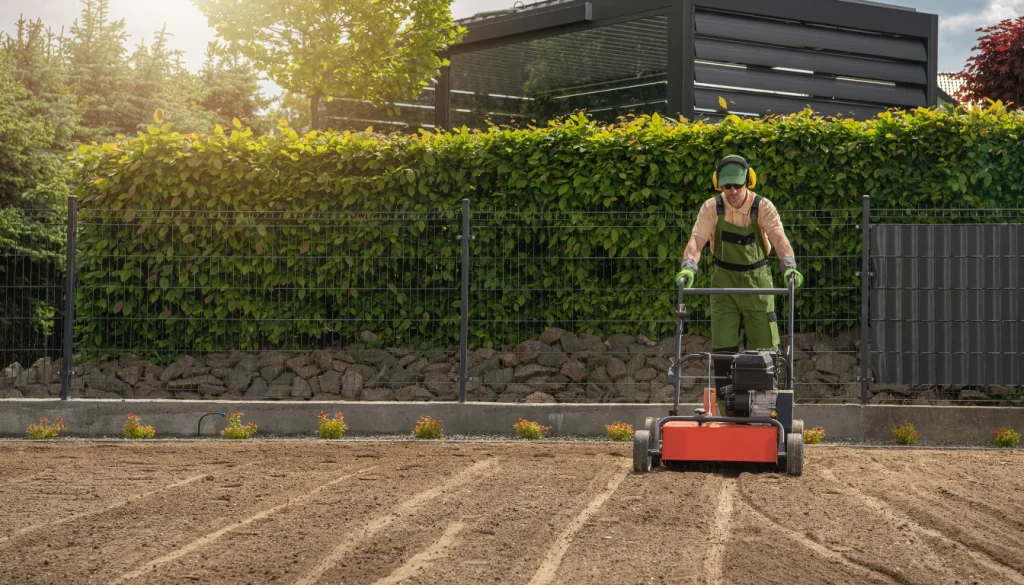
Soil Testing and Amendments
Soil tests are easy to do and can tell you a lot about your soil. They check pH levels, nutrient levels, and heavy metals. This info helps you make the right changes for healthy grass.
Based on the test results, you might need to add lime or sulfur. This depends on the type of grass you want to grow.
Effective Soil Preparation Techniques
Next, we focus on making your soil better physically. This means breaking up hard layers for better air and water. Adding compost can also help keep moisture in and nutrients available for new shoots.
Here’s a simple guide to soil prep:
- Tilling: Turn over the soil to loosen it and improve air and water flow.
- Leveling: Make the surface even to prevent water pooling and ensure seeds spread evenly.
- Adding Organic Matter: Use compost or peat moss to enrich the soil and improve its structure.
- Final Raking: Make the soil just right for planting, not too loose or too tight.
| Technique | Benefit | Recommended Frequency |
|---|---|---|
| Tilling | Improves aeration and drainage | Annually, before planting |
| Leveling | Ensures even seed application and growth | As needed, post-tilling |
| Organic Matter Addition | Boosts nutrient levels and soil structure | Annually, and as needed during planting |
| Final Raking | Creates optimal seed-to-soil contact | Immediately before seeding |
Each step is important for getting your soil ready for new grass. With the right prep, you’ll have a lush, green lawn that looks great and is healthy too.
How to Properly Sow Grass Seed for Best Results
Learning how to plant grass seed is key to a lush lawn. This guide will show you the best ways to sow grass seed. This ensures your lawn grows well and looks great.
Sowing Techniques for Even Coverage
There are different ways to spread grass seed evenly, depending on your lawn size and needs:
- Broadcasting: Great for big areas, this method uses a spreader or your hands to spread the seed.
- Using a Spreader: Drop or rotary spreaders give you more control. This is important for covering your yard evenly.
- Hand-Seeding: For small or patchy spots, seeding by hand lets you place seeds carefully. This makes sure every spot gets covered.
Common Mistakes When Planting Grass Seed
Even with the best methods, mistakes can still happen. Here are some common errors to watch out for:
- Failing to prepare the soil adequately: The soil should be loose, even, and free of debris. This helps seeds grow evenly and roots develop well.
- Ignoring the seed rate: Too much or too little seed can cause problems. Too much leads to competition, while too little results in uneven growth.
- Poor timing: Planting at the wrong time can hurt seed germination. Plant when the weather is best for your grass type.
Watering Your New Grass Seed: A Delicate Balance
Learning how to water grass seed right is key to a beautiful lawn. It’s not just about giving enough water for seeds to grow. You also need to avoid problems like seed washout or fungal diseases. Creating a good lawn watering schedule is essential.
When starting with germination watering techniques, aim for a moist but not wet seedbed. This helps seeds grow well without drowning or washing away. It’s best to water lightly and often, especially in the first weeks after seeding.
The right watering approach can make or break your new lawn’s ability to thrive. Always adjust your techniques based on the weather conditions and the type of soil in your yard.
Here’s a simple watering plan:
- Week 1-2: Water lightly twice a day to keep seeds damp. Avoid pooling water which can displace seeds.
- Week 3-4: Reduce watering to once a day, allowing the top inch of soil to start drying out between sessions.
- Week 5 onward: Gradually transition to deeper, less frequent watering to encourage roots to grow deeper into the soil.
Watch your lawn for signs of too much or too little water. If it looks pale or washed out, it might not be getting enough water. But if it’s too wet or has mold, it’s getting too much.
| Signs of Good Watering Practices | Signs of Poor Watering Practices |
|---|---|
| Evenly green, vibrant grass growth | Discolored or patchy grass |
| Soil is damp but not soggy | Muddy or waterlogged soil |
| No signs of seed washout | Visible erosion or seed displacement |
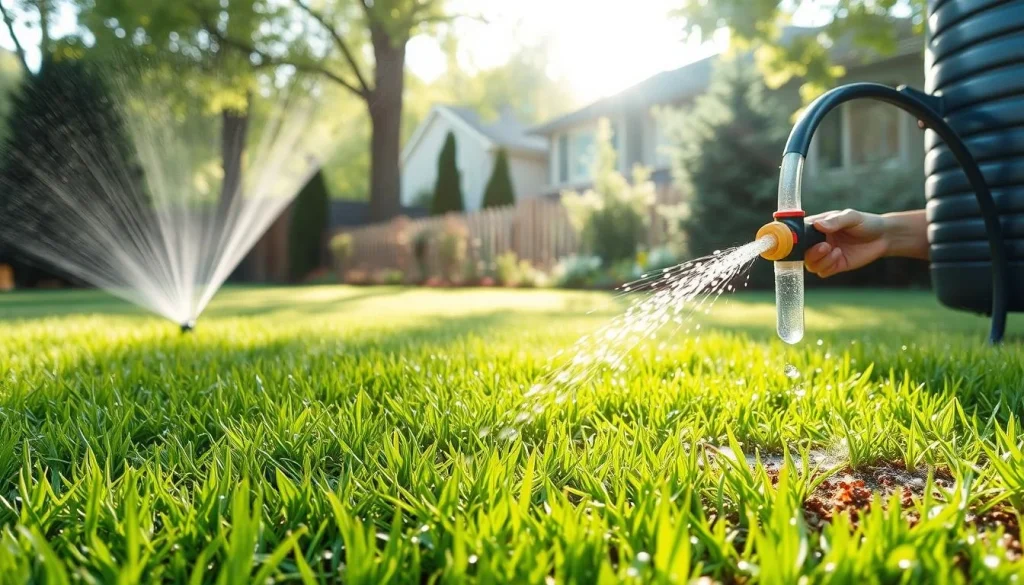
Getting your lawn watering schedule right is crucial for your lawn’s health. It helps your grass grow evenly and strong. Remember, every lawn is different. So, pay attention and adjust your watering as needed for your lawn’s specific needs.
Maintaining Your Lawn for Quicker Germination and Growth
Keeping your lawn in top shape is key for fast grass growth. This part talks about the best ways to mow, fertilize, and control weeds. These steps help your lawn stay healthy and green.
Mowing Practices for New Grass
Choosing the right mowing method is vital for new lawns. Don’t cut your lawn too soon. Wait until it’s at least 3 inches tall. This gives the grass the strength it needs to handle the cut.
Use a sharp blade to cut the grass. This helps prevent diseases from getting into the blades.
Fertilization and Weed Control
Choosing the right fertilizer is as important as controlling weeds for new lawns. Fertilize in a way that helps the grass grow fast without overdoing it. This prevents the grass from growing too much and losing its roots.
Also, use weed control early on to stop weeds from taking over. This is key to let the grass grow strong.
Remember, the main goal is to care for your lawn. This way, it can grow quickly and healthily.
| Activity | Frequency | Benefits |
|---|---|---|
| Mowing | Every 5-7 days | Promotes thicker lawn, prevents weeds |
| Fertilization | Once every 6 weeks | Supports root and blade development |
| Weed Control | As needed | Reduces competition for resources |
The Answer: How Long Does It Take for Grass Seed to Grow
Understanding grass seed growth expectation involves several key factors. These include the type of grass seed, the planting season, and the care it gets. Let’s look at a typical seed-to-lawn timeline and what to expect during the lawn establishment period.
Grass seed germination times vary greatly. Quick-growing seeds like perennial ryegrass sprout in 5 to 10 days under the right conditions. On the other hand, Kentucky bluegrass may take 14 to 30 days to germinate.
| Grass Type | Expected Germination Time | Care Level |
|---|---|---|
| Perennial Ryegrass | 5-10 days | Moderate |
| Kentucky Bluegrass | 14-30 days | High |
| Tall Fescue | 7-12 days | Low |
Once the seeds germinate, the focus is on helping the young grass grow into a dense, healthy lawn. Factors like watering, mowing, and fertilization are crucial. They must match the specific needs of the grass type.
Patience is key during the lawn establishment period. A newly seeded lawn usually takes 6 to 12 months to fully establish. This wait is worth it for a lush, lasting lawn that will thrive for years.
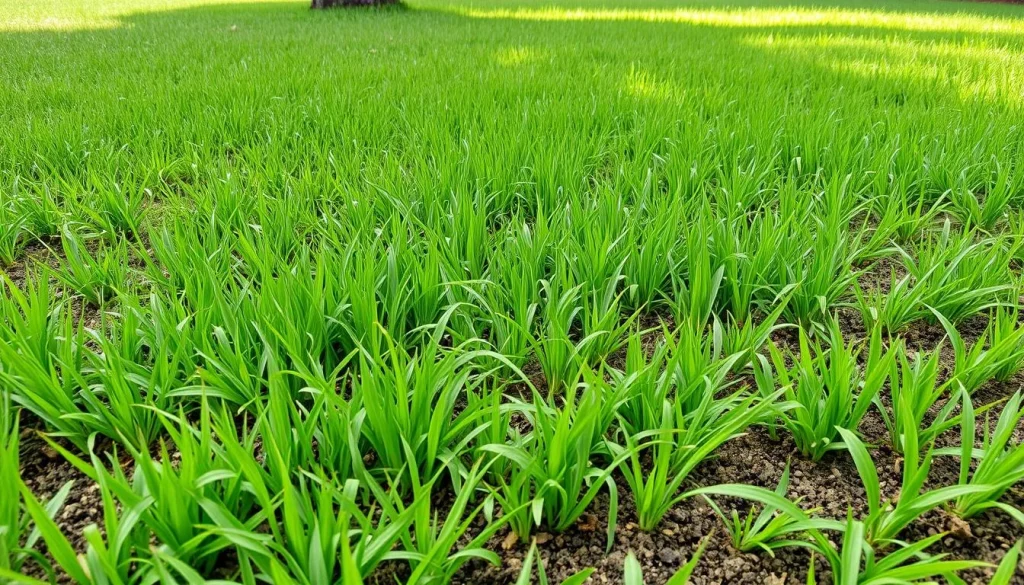
Get more information about Growing Crops:
Conclusion
Starting a journey to a lush green yard is all about knowing the basics of lawn seeding. We’ve covered everything from germination to the best times to plant. This knowledge helps you make smart choices for your garden.
We’ve also talked about different grass seed types and how they grow. It’s clear that soil prep and sowing right are key to success. These steps are crucial for a healthy garden.
By watching over your lawn with care, including watering and mowing, you help it grow. A summary of grass seed growth shows patience and regular care lead to the best lawns. Sticking to these habits is essential for a beautiful outdoor space.
This article is your guide to a successful lawn. Even with challenges, you’re ready to face them. A beautiful lawn is the reward for all your hard work.
We hope you use these tips to grow a lush green yard. Start with the seeds of potential and watch your lawn flourish.
FAQ
What factors affect how long it takes for grass seed to grow?
Many things can change how fast grass seed grows. These include the type of grass, where you plant it, and how you care for it. Weather like temperature and moisture also plays a big role.
How does temperature and moisture influence grass seed germination?
Temperature and moisture are very important for seeds to start growing. Seeds need the right temperature to start growing. They also need steady moisture to grow well.
What are the stages of grass seed germination?
Seeds go through a few stages to grow. First, they absorb water. Then, they start to develop inside the seed. Finally, they sprout out of the soil.
What is the best time of year to plant grass seed for successful growth?
The best time to plant grass seed varies by climate. But, early fall or spring are usually best. These times have good weather and lots of rain for seeds to grow well.
Which types of grass seed grow the fastest?
Some grass seeds grow faster than others. Perennial Ryegrass is one of the fastest. It grows quicker than many other types, like Kentucky Bluegrass.
Why is soil preparation important before planting grass seed?
Preparing the soil is key before planting. It should be tested and amended to be rich and well-aerated. This helps seeds grow better by improving contact with the soil and keeping water in.
What are the best techniques for sowing grass seed?
There are a few good ways to sow grass seed. Broadcasting is good for big areas. For small spaces, hand-seeding works best. It’s important to cover the area evenly for a uniform lawn.
How often should I water new grass seed?
New grass needs to be watered often but lightly. This keeps the soil moist without washing away seeds. Once the seeds sprout, water deeper but less often to help roots grow strong.
Can mowing practices affect the germination and growth of new grass?
Yes, mowing is important for new grass. Wait until it’s 3 inches tall before mowing. Use sharp blades and don’t cut too much at once to avoid stressing the grass.
How does proper lawn maintenance contribute to quicker grass seed germination and growth?
Taking care of your lawn helps seeds grow faster. Water, fertilize, and mow correctly. Also, controlling weeds early on helps the new grass get the resources it needs.
How long should I expect to wait before seeing my new grass seed fully grow?
How long it takes for grass to grow depends on the type. Some grow in 5-10 days, while others take 2-4 weeks to start. It can take months for a full lawn. Be patient and take good care of your lawn for the best results.

